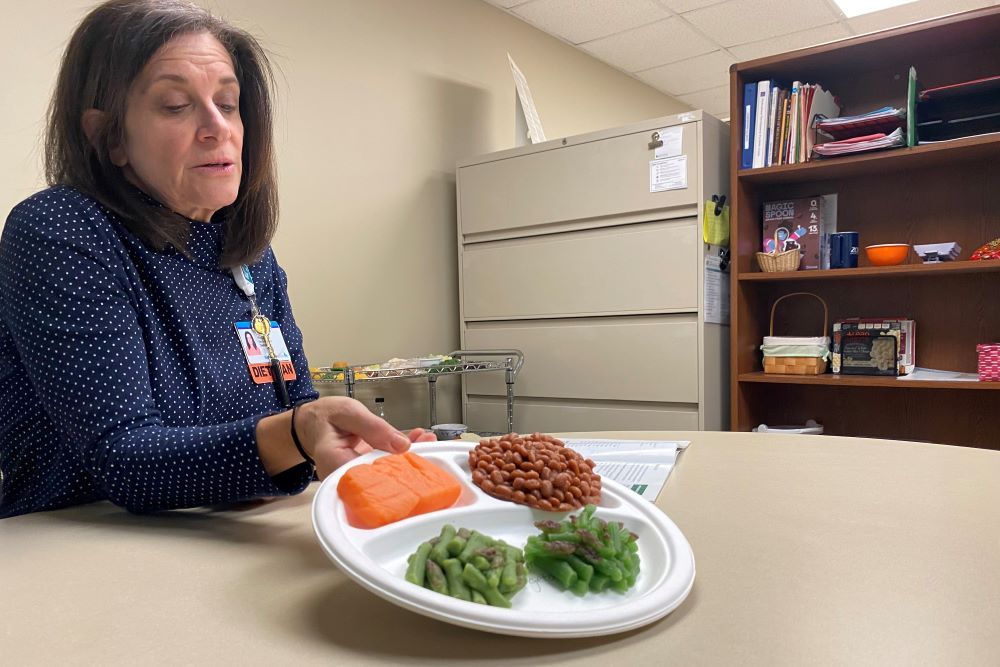Diabetes and Endocrinology
Want to learn more about this at Kettering Health?
“You are what you eat”: it’s the mantra of home-ec teachers and the final appeal of mothers locked in a battle of wits with picky eaters refusing the vegetables.
This phrase, which dates back to 1826, first explored the deep connections among food, culture, and identity—not necessarily nutrition.
In the 1930s, the phrase left the loftiness of philosophy for the world of nutrition education. And by the ’70s, “you are what you eat” was the token phrase of family dinners and public service announcements.
“The idea was to say, ‘If you’re eating a balanced diet, you’ll have better health outcomes,’” Registered Dietitian and Diabetes Educator Michele Geiger says.
But today, Michele helps patients look at this phrase a little differently, with a small revision.
“I try to remind patients that ‘You are what you don’t eat.’ is just as true.”
Back to the basics
“Food is the cornerstone of our health,” Michele says. “What we eat and drink fuels our bodies to grow and function correctly.”
We often forget this, as we punctuate our busy days with drive-thru meals and sugary snacks and beverages.
The food we eat provides two sources of sustenance to our bodies: macronutrients (macros) and micronutrients (micros). Macros—protein, carbs, and fats—provide the main source of fuel. Micros—vitamins and minerals—feed our bodies nutrients, helping them function properly.
When it comes to our food intake, our bodies crave variety. “The body’s systems work well when we eat different foods in each food category,” Michele says, “including dairy, meat, fruits, fats, and vegetables. If you have a little bit of food diversity, it can really help you.”
Eating the same food—even if it’s healthy—actually deprives our bodies of some of the macros and micros it needs. And that’s where trouble can start.
“If you don’t feel good,” Michele says, “look at your diet.”
This is especially true for her patients who avoid vegetables.
Go with your gut
Many of the micros our bodies need come from plants, namely vegetables. “Vegetables are mostly vitamins and minerals, including fiber,” Michele says. And fiber does wonders for our bodies. Fiber helps us to feel full and not overeat. It also helps keep bowel movements regular, and it feeds the beneficial bacteria that help keep our bodies healthy.
Your body is full of trillions of bacteria and other microscopic organisms. Together, they’re known as the microbiome.
Much of this microbiome is inside the intestines, specifically in a “pocket” of the large intestine called the cecum. Experts often call this the gut microbiome.
“The stomach area, we’re learning, is the key to our overall health,” Michele says. “And when the microbiome isn’t happy, things happen.”
In other words, when your diet lacks the nutrients your microbiome needs, you feel it: headaches, nausea, sleeplessness, skin irritation, constipation, and bloating.
“Many of my patients have gut problems,” Michele says, “such as excessive gas, bloating, stomach pain, diarrhea, and constipation.”
Experts like Michele know feeling good and being healthy is complex. But she’ll tell you, like she tells anyone, our health starts and circles back to our diets.
Her recommendation: add some plant-based foods to your diet.
Plant-based foods certainly include fruits and vegetables. But beans, seeds, and nuts (and cooking oils made from these foods) also help round out a plate balanced by plant-based options.
Thirty in seven
To help, Michele offers a challenge: try to eat 30 different plant-based foods in seven days.
It sounds like a lot. But Michele points out that a typical salad has three to four different leafy vegetables. Add some ingredients like almonds, cherries, cherry tomatoes, and even avocado, now you have six to seven plant-based foods in one salad—one-fourth of the way there.
So, if you’re tired, bloated, or just feeling “off,” Michele suggests checking your plate. And consider starting with the advice many of us grew up with to “eat your vegetables.”










